Rocky Mountaineer
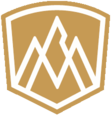 | |
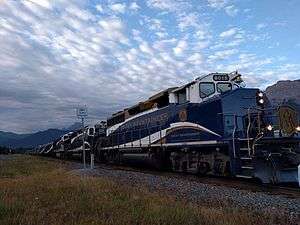 | |
| Reporting mark | RMRX |
|---|---|
| Locale | British Columbia and Alberta |
| Dates of operation | 1990–Present |
| Track gauge | 4 ft 8 1⁄2 in (1,435 mm) |
| Headquarters | Vancouver, British Columbia |
| Website |
www |
Rocky Mountaineer is a Canadian rail-tour company offering Western Canadian vacation packages that operates trains on four rail routes through British Columbia, Alberta, and the US state of Washington.
History
Since its inception in 1990, the British Columbia based family owned business, Rocky Mountaineer, has grown to become the largest privately owned luxury tourist train company in the world, serving over 1.7 million guests on its four routes.[1]
1990 - The Federal Government decided to cut VIA Rail’s heavily subsidized operation and privatize its daylight tourist service. The Great Canadian Railtour Company (GCRC)—owner of Rocky Mountaineer was awarded the right to operate the routes and purchase VIA Rail’s equipment. Under the leadership of company founder Peter Armstrong, a select group of former railroad executives and tourism experts created a vision for Rocky Mountaineer, a two-day, all daylight journey through the Canadian Rockies.
1995 - The company launched its Rocky Mountaineer GoldLeaf Service, a premier class featuring bi-level custom-built glass dome coaches with panoramic views on the upper level and a dining room and observation deck on the lower level.
1996 - Rocky Mountaineer set the record for longest passenger train in Canadian history with 37 cars.
1999 - Rocky Mountaineer broke its own previous record with 41 cars.
2005 - The newly-formed Armstrong Group (AG) replaced GCRC as Rocky Mountaineer’s parent company.
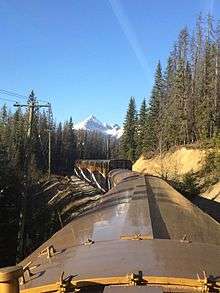
2006 - Rocky Mountaineer launched two new tourist train routes: Whistler Sea to Sky Climb, a day trip between North Vancouver and Whistler, BC; and Rainforest to Gold Rush route, which travels through Whistler and Jasper, AB.
2008 - Rocky Mountaineer welcomed onboard its One Millionth Guest, from Superior, Wisconsin USA.
2009 - ABC’s hit reality TV series, The Bachelorette, featured a four-day rail journey onboard Rocky Mountaineer.
2010 - Rocky Mountaineer celebrated its 20th anniversary. Rocky Mountaineer also operated an exclusive train on behalf of the Province of Alberta during the 2010 Winter Olympics. VIPs, celebrities, athletes, and media were among the guests on this daily service between Vancouver and Whistler. The largest passenger departure in Rocky Mountaineer’s history departed with 1,323 guests in October.
2012 - Rocky Mountaineer introduced their newest level of service, SilverLeaf Service on the First Passage to the West route running between Vancouver, BC and Banff, AB. Rocky Mountaineer began running their bi-level dome cars on the Whistler Sea to Sky Climb route.
2013 - Rocky Mountaineer launched their new Coastal Passage route, connecting Seattle, WA to Vancouver, BC. After having success launching SilverLeaf Service on the First Passage to the West route in 2012, Rocky Mountaineer added this new level of service to their Journey Through the Clouds route between Vancouver, BC and Jasper, AB. A new destination, Lake Louise, AB became an optional destination on Rocky Mountaineer’s First Passage to the West route. Rocky Mountaineer launched a new annual corporate giving program, Train for Heroes. Every year, Rocky Mountaineer selects a group of heroes that give selflessly for the good of others and invite them onto the train for a life changing experience of their own. The launch of the program celebrated wounded soldiers/veterans. The program has since celebrated various organ donation organizations in 2014, the Starlight Children’s Foundation in 2015 and the unsung heroes of the 2016 fires in Fort McMurray, Alberta in 2016.
2014 - SilverLeaf Service began being offered on three routes, First Passage to the West, Journey through the Clouds, and Coastal Passage.
2015 - Rocky Mountaineer celebrated their 25th Anniversary.
2016 - Rocky Mountaineer extended its season by two weeks, ending in mid-October.
Awards
Rocky Mountaineer has been awarded the "World's Leading Travel Experience by Train" at the World Travel Awards seven times[3] for its GoldLeaf service and was recognized by National Geographic Magazine as one of the "World’s Best Journeys" in 2007. The Society of American Travel Writers, the world’s largest organization of professional travel journalists and photographers, rated the Rocky Mountaineer as the world's top train ride in 2009.[4]
Official list of Rocky Mountaineer's awards and accolades
Routes
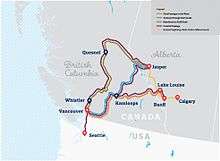
Rocky Mountaineer operates train journeys over four principal routes:
First Passage to the West
Rocky Mountaineer’s first route travels along Kicking Horse River, through the Spiral Tunnels, the location where the last spike on the Canadian Pacific Railway was driven, and various other landmarks from the early days of the National Railway. This route is famous for uniting the country and connecting British Columbia to Canada over 125 years ago. Rocky Mountaineer is the only passenger rail service that operated on this route.[5]
Journey through the Clouds
This route travels through the Coastal Mountain Range and the Fraser Canyon. The train follows the route of the Fraser River, passing by the Albreda Glacier and Pyramid Falls. Regarded as top highlight of this route is Mount Robson, the highest peak in the Canadian Rockies.[6]
Rainforest to Gold Rush
Rocky Mountaineer’s three-day route travels through the coastal rainforest, the Rocky Mountain Trench, Mount Robson, and the desert-like conditions of the Fraser Canyon into the ranchlands of the Cariboo Plateau. Stopping for a night in the Gold Pan City of Quesnel.[7]
Coastal Passage
Rocky Mountaineer’s newest route connects the city of Seattle, WA, USA with Vancouver, BC and through to the Canadian Rockies. Guests experience an all daylight journey onboard the Rocky Mountaineer travelling along the Pacific Ocean's sparkling coastline, through lush rainforests and between the Canadian Rockies. [8]
Service Levels
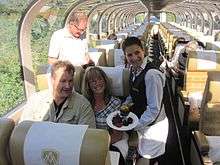
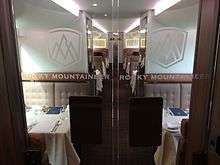
GoldLeaf
Operating on all routes, Rocky Mountaineer’s GoldLeaf service is a custom-designed, bi-level, glass-domed coach with full-length windows and reclining seats that can be rotated to accommodate groups of four. Guests onboard this service are attend to by three to four onboard hosts, in addition to the culinary team. Guests are offered hot gourmet meals prepared onboard the train, and served to them in the lower level dinning car. Beverages are also offered to guests throughout the journey, along with gourmet snacks. The two levels of the GoldLeaf coach are accessible by a spiral staircase or an ADA elevator.[9][10]
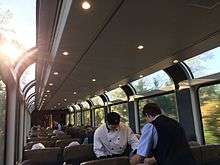
SilverLeaf
Operating on the same routes as GoldLeaf, Rocky Mountaineer’s SilverLeaf service is a custom-designed, single level glass domed coach with oversized windows and reclining seats. Guests onboard are attended to by two to three onboard hosts, and offered a hot entrée option for breakfast and lunch served at their seat and plated to their preference. Complimentary beverages are served throughout the journey, including: wine, beer, spirits, and non-alcoholic drinks. Gourmet snacks are also offered throughout the journey.[11][12]
RedLeaf
Previously operating on the now retired Whistler Sea to Sky climb route, Rocky Mountaineer’s RedLeaf service was a single-level coach featuring large picture windows. Guest onboard this service were attended to by a single onboard host, and served chilled meals at their seat and a complimentary wine or beer with lunch. Similar to GoldLeaf and SilverLeaf, non-alcoholic beverages and storytelling by the onboard host were also featured in RedLeaf. Rocky Mountaineer retired RedLeaf service after the 2015 season. [13]
Trip structure
To allow for the best views, Rocky Mountaineer operate exclusively during the day. On the First Passage to the West and on Journey Through the Clouds routes an overnight stop is made in Kamloops, whilst on the Rainforest to Gold Rush route, there are two overnight stops; in Whistler and Quesnel. The Rocky Mountaineer season runs from late April to mid-October with multiple departures every week going both eastbound and westbound. Coastal Passage runs southbound and northbound on select weekends throughout the season.
Connecting services
The nearest international airports to Rocky Mountaineer are the Calgary International Airport and Vancouver International Airport.
In Vancouver, Rocky Mountaineer trains depart from the Rocky Mountaineer Station, while other rail services operate out of either Pacific Central Station (Amtrak and Via Rail) or Waterfront Station (WestCoast Express).
At the Jasper railway station passengers can transfer directly to Via Rail's Canadian and Jasper – Prince Rupert train service.
Notes
- ↑ http://www.rockymountaineer.com/en_CA_BC/about_us/our_history
- ↑ http://www.rockymountaineer.com/en_CA_BC/resources/public/RK_MediaKit_Jan2016_History_v2.pdf
- ↑ "Rocky Mountaineer GoldLeaf Service". 2012. Retrieved 9 February 2014.
- ↑ "Travel writers select the world's top 10 train rides". Travel Industry Today. 16 July 2009. Retrieved 9 February 2014.
- ↑ http://www.rockymountaineer.com/en_CA_BC/routes_and_packages/canadian_rocky/first_passage_to_the_west
- ↑ http://www.rockymountaineer.com/en_CA_BC/routes_and_packages/canadian_rocky/journey_through_the_clouds
- ↑ http://www.rockymountaineer.com/en_CA_BC/routes_and_packages/canadian_rocky/rainforest_to_gold_rush
- ↑ http://www.rockymountaineer.com/en_CA_BC/routes_and_packages/canadian_rocky/coastal_passage
- ↑ http://www.rockymountaineer.com/en_CA_BC/service_level/canadian_rocky/goldleaf
- ↑ Source: Rocky Mountaineer – 25 Years of Life Changing Experiences – 2015 Canada Train travel Guide (page 19)
- ↑ http://www.rockymountaineer.com/en_CA_BC/service_level/canadian_rocky/silverleaf
- ↑ Source: Rocky Mountaineer – 25 Years of Life Changing Experiences – 2015 Canada Train travel Guide (page 19)
- ↑ Source: Rocky Mountaineer – 25 Years of Life Changing Experiences – 2015 Canada Train travel Guide (page 18-19)
References
- Johnston, Bob (February 2016). "It takes more than scenery". Trains. 76 (2).
External links
| Wikimedia Commons has media related to Rocky Mountaineer. |